西方餐饮及其文化(中英文)
- 格式:pptx
- 大小:2.75 MB
- 文档页数:28
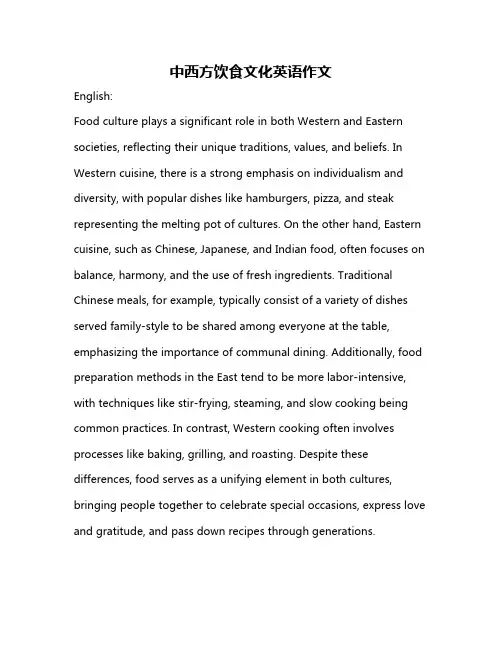
中西方饮食文化英语作文English:Food culture plays a significant role in both Western and Eastern societies, reflecting their unique traditions, values, and beliefs. In Western cuisine, there is a strong emphasis on individualism and diversity, with popular dishes like hamburgers, pizza, and steak representing the melting pot of cultures. On the other hand, Eastern cuisine, such as Chinese, Japanese, and Indian food, often focuses on balance, harmony, and the use of fresh ingredients. Traditional Chinese meals, for example, typically consist of a variety of dishes served family-style to be shared among everyone at the table, emphasizing the importance of communal dining. Additionally, food preparation methods in the East tend to be more labor-intensive, with techniques like stir-frying, steaming, and slow cooking being common practices. In contrast, Western cooking often involves processes like baking, grilling, and roasting. Despite these differences, food serves as a unifying element in both cultures, bringing people together to celebrate special occasions, express love and gratitude, and pass down recipes through generations.中文翻译:食物文化在西方和东方社会中都起着重要的作用,反映了它们独特的传统、价值观和信仰。
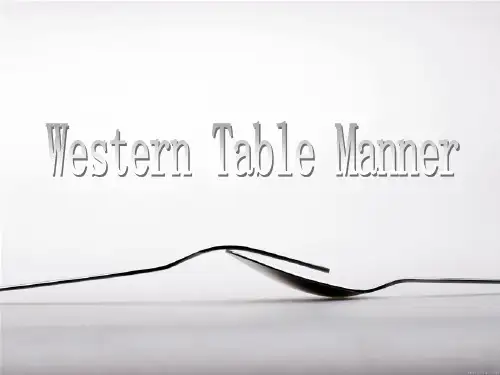
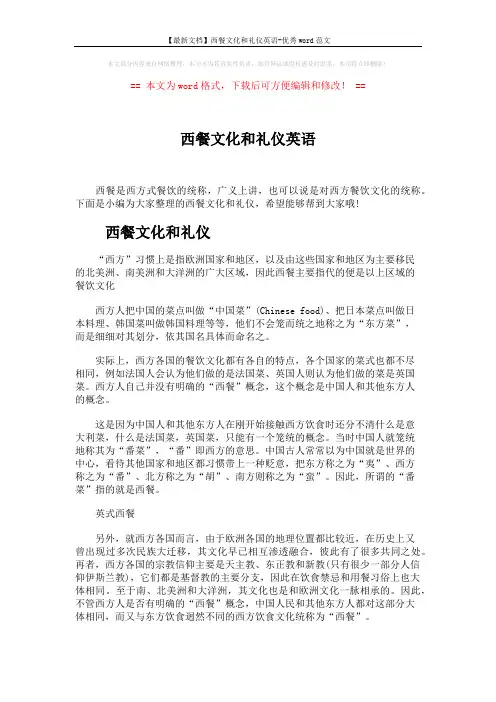
本文部分内容来自网络整理,本司不为其真实性负责,如有异议或侵权请及时联系,本司将立即删除!== 本文为word格式,下载后可方便编辑和修改! ==西餐文化和礼仪英语西餐是西方式餐饮的统称,广义上讲,也可以说是对西方餐饮文化的统称。
下面是小编为大家整理的西餐文化和礼仪,希望能够帮到大家哦!西餐文化和礼仪“西方”习惯上是指欧洲国家和地区,以及由这些国家和地区为主要移民的北美洲、南美洲和大洋洲的广大区域,因此西餐主要指代的便是以上区域的餐饮文化西方人把中国的菜点叫做“中国菜”(Chinese food)、把日本菜点叫做日本料理、韩国菜叫做韩国料理等等,他们不会笼而统之地称之为“东方菜”,而是细细对其划分,依其国名具体而命名之。
实际上,西方各国的餐饮文化都有各自的特点,各个国家的菜式也都不尽相同,例如法国人会认为他们做的是法国菜、英国人则认为他们做的菜是英国菜。
西方人自己并没有明确的“西餐”概念,这个概念是中国人和其他东方人的概念。
这是因为中国人和其他东方人在刚开始接触西方饮食时还分不清什么是意大利菜,什么是法国菜,英国菜,只能有一个笼统的概念。
当时中国人就笼统地称其为“番菜”,“番”即西方的意思。
中国古人常常以为中国就是世界的中心,看待其他国家和地区都习惯带上一种贬意,把东方称之为“夷”、西方称之为“番”、北方称之为“胡”、南方则称之为“蛮”。
因此,所谓的“番菜”指的就是西餐。
英式西餐另外,就西方各国而言,由于欧洲各国的地理位置都比较近,在历史上又曾出现过多次民族大迁移,其文化早已相互渗透融合,彼此有了很多共同之处。
再者,西方各国的宗教信仰主要是天主教、东正教和新教(只有很少一部分人信仰伊斯兰教),它们都是基督教的主要分支,因此在饮食禁忌和用餐习俗上也大体相同。
至于南、北美洲和大洋洲,其文化也是和欧洲文化一脉相承的。
因此,不管西方人是否有明确的“西餐”概念,中国人民和其他东方人都对这部分大体相同,而又与东方饮食迥然不同的西方饮食文化统称为“西餐”。
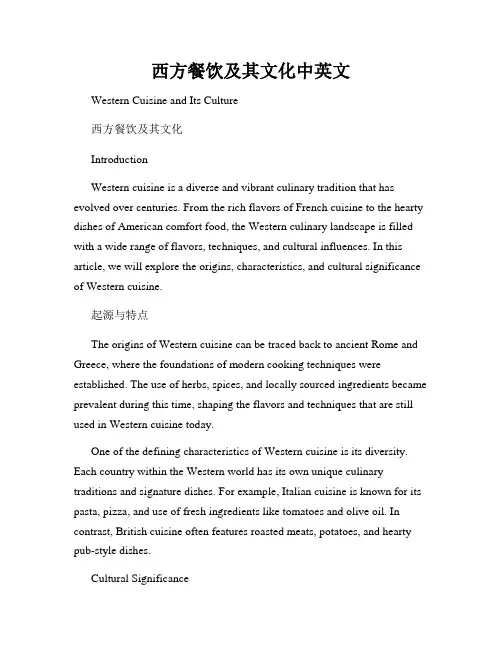
西方餐饮及其文化中英文Western Cuisine and Its Culture西方餐饮及其文化IntroductionWestern cuisine is a diverse and vibrant culinary tradition that has evolved over centuries. From the rich flavors of French cuisine to the hearty dishes of American comfort food, the Western culinary landscape is filled with a wide range of flavors, techniques, and cultural influences. In this article, we will explore the origins, characteristics, and cultural significance of Western cuisine.起源与特点The origins of Western cuisine can be traced back to ancient Rome and Greece, where the foundations of modern cooking techniques were established. The use of herbs, spices, and locally sourced ingredients became prevalent during this time, shaping the flavors and techniques that are still used in Western cuisine today.One of the defining characteristics of Western cuisine is its diversity. Each country within the Western world has its own unique culinary traditions and signature dishes. For example, Italian cuisine is known for its pasta, pizza, and use of fresh ingredients like tomatoes and olive oil. In contrast, British cuisine often features roasted meats, potatoes, and hearty pub-style dishes.Cultural SignificanceWestern cuisine plays a significant role in shaping and reflecting the culture of the Western world. It is often seen as a symbol of sophistication, luxury, and indulgence. Many Western dishes are associated with special occasions or celebrations, such as Thanksgiving in the United States or Christmas dinner in Europe.The dining experience in Western culture is also highly valued. The act of sharing a meal with friends and family is seen as a way to foster relationships and create meaningful connections. In many Western countries, gathering for a meal is a time to relax, unwind, and engage in lively conversation.Moreover, Western cuisine has had a major influence on global food culture. With the expansion of European colonial powers, Western ingredients, cooking techniques, and dishes were introduced to other parts of the world. As a result, you can now find Italian pizzerias in Japan, American fast-food chains in China, and French bakeries in South America.The Impact of GlobalizationIn recent years, the globalization of food has led to the fusion of Western and non-Western culinary traditions. This can be seen in the popularity of fusion cuisine, where chefs combine ingredients and techniques from different cultures to create innovative and exciting dishes.The rise of social media and food blogging has also contributed to the spread of Western cuisine worldwide. People from all corners of the globe can now easily access recipes, cooking tips, and cultural insights related to Western cuisine. This has created a greater appreciation and understanding of Western food culture.ConclusionWestern cuisine is a rich tapestry of flavors, techniques, and cultural influences. From the traditional dishes of Italy to the modern innovations of American cuisine, Western food continues to captivate and inspire people around the world. Its diverse and vibrant nature makes it a truly global culinary tradition that goes beyond borders and brings people together.结论西方餐饮是一幅丰富多彩的风味、技术和文化影响交织成的画卷。
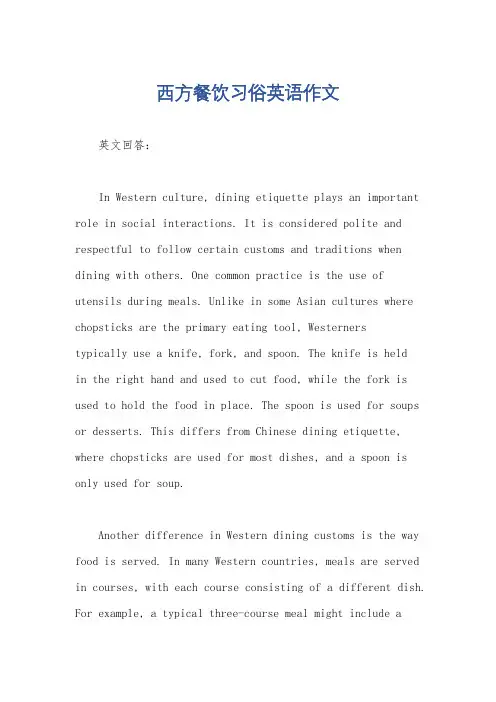
西方餐饮习俗英语作文英文回答:In Western culture, dining etiquette plays an important role in social interactions. It is considered polite and respectful to follow certain customs and traditions when dining with others. One common practice is the use of utensils during meals. Unlike in some Asian cultures where chopsticks are the primary eating tool, Westernerstypically use a knife, fork, and spoon. The knife is heldin the right hand and used to cut food, while the fork is used to hold the food in place. The spoon is used for soups or desserts. This differs from Chinese dining etiquette, where chopsticks are used for most dishes, and a spoon is only used for soup.Another difference in Western dining customs is the way food is served. In many Western countries, meals are served in courses, with each course consisting of a different dish. For example, a typical three-course meal might include astarter, main course, and dessert. Each course is served separately and eaten in a specific order. This is different from Chinese dining, where multiple dishes are served at once and shared among the diners. In Chinese culture, it is common for everyone to take a small portion of each dish using their chopsticks.Furthermore, table manners are an important aspect of Western dining etiquette. It is considered impolite to talk with food in your mouth or make loud noises while eating. Additionally, it is customary to wait for everyone to be served before starting to eat. In Chinese culture, talking and eating at the same time is more acceptable, and it is not necessary to wait for everyone to be served before beginning the meal. However, it is still important to show respect and not make excessive noise while eating.Moreover, the way drinks are consumed also differs between Western and Chinese dining customs. In Western culture, it is common to have a glass of water or a beverage of choice alongside the meal. It is acceptable to take sips throughout the meal to cleanse the palate. On theother hand, in Chinese culture, tea is often served with meals. It is customary to take small sips of tea between bites of food to enhance the flavors.In conclusion, Western dining etiquette differs from Chinese dining customs in various aspects. From the use of utensils to the way food is served and consumed, there are notable differences between the two cultures. It is important to be aware of these differences when dining with individuals from different cultural backgrounds to show respect and avoid any misunderstandings.中文回答:在西方文化中,就餐礼仪在社交互动中起着重要的作用。
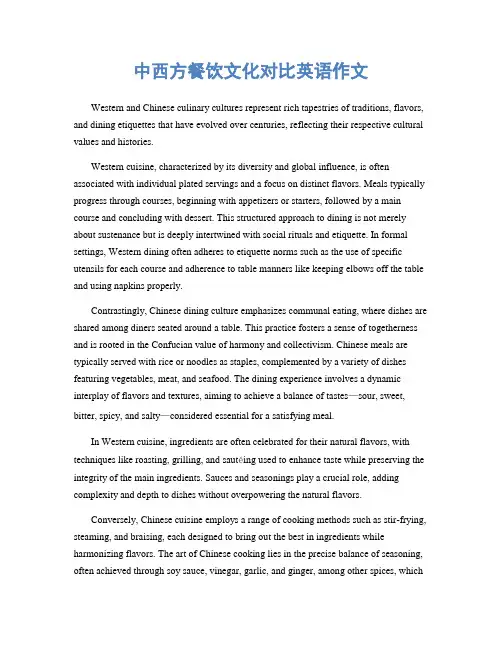
中西方餐饮文化对比英语作文Western and Chinese culinary cultures represent rich tapestries of traditions, flavors, and dining etiquettes that have evolved over centuries, reflecting their respective cultural values and histories.Western cuisine, characterized by its diversity and global influence, is often associated with individual plated servings and a focus on distinct flavors. Meals typically progress through courses, beginning with appetizers or starters, followed by a main course and concluding with dessert. This structured approach to dining is not merely about sustenance but is deeply intertwined with social rituals and etiquette. In formal settings, Western dining often adheres to etiquette norms such as the use of specific utensils for each course and adherence to table manners like keeping elbows off the table and using napkins properly.Contrastingly, Chinese dining culture emphasizes communal eating, where dishes are shared among diners seated around a table. This practice fosters a sense of togetherness and is rooted in the Confucian value of harmony and collectivism. Chinese meals are typically served with rice or noodles as staples, complemented by a variety of dishes featuring vegetables, meat, and seafood. The dining experience involves a dynamic interplay of flavors and textures, aiming to achieve a balance of tastes—sour, sweet, bitter, spicy, and salty—considered essential for a satisfying meal.In Western cuisine, ingredients are often celebrated for their natural flavors, with techniques like roasting, grilling, and sautéing used to enhance taste while preserving the integrity of the main ingredients. Sauces and seasonings play a crucial role, adding complexity and depth to dishes without overpowering the natural flavors.Conversely, Chinese cuisine employs a range of cooking methods such as stir-frying, steaming, and braising, each designed to bring out the best in ingredients while harmonizing flavors. The art of Chinese cooking lies in the precise balance of seasoning, often achieved through soy sauce, vinegar, garlic, and ginger, among other spices, whichare used not just for taste but also for their health benefits according to traditional Chinese medicine principles.Furthermore, dining customs in both cultures reflect broader societal values. In the West, meals are often a time for family bonding or socializing with friends, marked by lively conversation and shared experiences. Special occasions are celebrated with elaborate dinners, where food serves as a centerpiece of festivities.Similarly, in Chinese culture, food is deeply symbolic and is intricately woven into festivals and rituals, embodying auspicious meanings and cultural heritage. The preparation and sharing of food signify respect and affection for guests, with hosts often demonstrating generosity by offering a wide array of dishes to ensure guests' enjoyment and satisfaction.Despite these cultural distinctions, globalization has facilitated the exchange and fusion of culinary traditions. Western influences can be seen in the adoption of fast food and casual dining concepts in urban China, while Chinese cuisine has gained popularity worldwide, adapted to local tastes and preferences.In conclusion, while Western and Chinese culinary cultures differ significantly in their approaches to dining, both are rich in tradition, symbolism, and culinary expertise. Whether enjoying a formal dinner in the West or partaking in a communal feast in China, the appreciation for food as a unifying force remains universal, transcending cultural boundaries and enriching the human experience.。
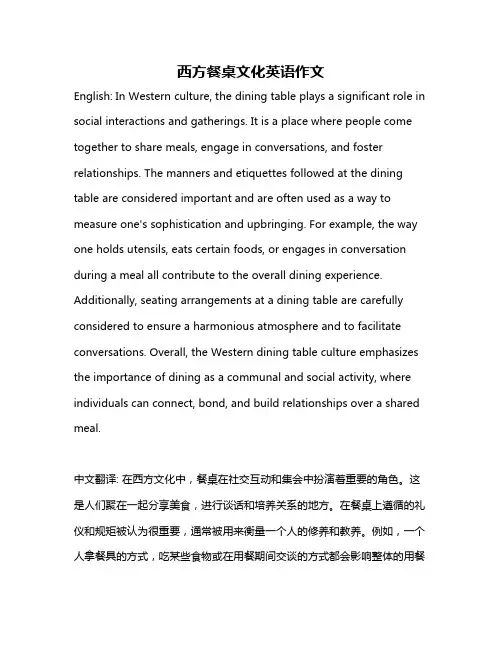
西方餐桌文化英语作文English: In Western culture, the dining table plays a significant role in social interactions and gatherings. It is a place where people come together to share meals, engage in conversations, and foster relationships. The manners and etiquettes followed at the dining table are considered important and are often used as a way to measure one's sophistication and upbringing. For example, the way one holds utensils, eats certain foods, or engages in conversation during a meal all contribute to the overall dining experience. Additionally, seating arrangements at a dining table are carefully considered to ensure a harmonious atmosphere and to facilitate conversations. Overall, the Western dining table culture emphasizes the importance of dining as a communal and social activity, where individuals can connect, bond, and build relationships over a shared meal.中文翻译: 在西方文化中,餐桌在社交互动和集会中扮演着重要的角色。
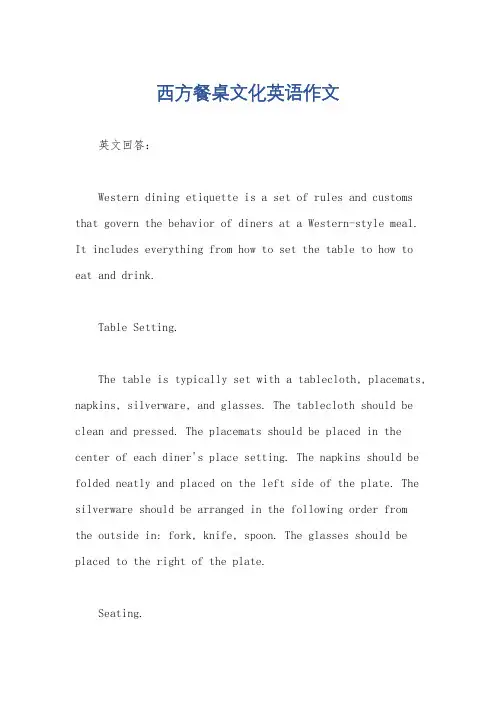
西方餐桌文化英语作文英文回答:Western dining etiquette is a set of rules and customs that govern the behavior of diners at a Western-style meal. It includes everything from how to set the table to how to eat and drink.Table Setting.The table is typically set with a tablecloth, placemats, napkins, silverware, and glasses. The tablecloth should be clean and pressed. The placemats should be placed in the center of each diner's place setting. The napkins should be folded neatly and placed on the left side of the plate. The silverware should be arranged in the following order from the outside in: fork, knife, spoon. The glasses should be placed to the right of the plate.Seating.Diners should arrive at the table on time. They should sit down in their assigned seats. The host or hostess will typically indicate where each diner should sit.Ordering.Once everyone is seated, the waiter or waitress will take orders. Diners should order their food and drinks in a polite and clear voice. They should not interrupt other diners when they are ordering.Eating.Diners should eat their food slowly and quietly. They should not talk with their mouths full. They should not make loud noises when they are eating.Drinking.Diners should sip their drinks slowly and quietly. They should not drink too much alcohol.Conversation.Conversation at the table should be polite and respectful. Diners should not talk about controversial topics. They should not gossip about other people.Leaving the Table.When diners are finished eating, they should excuse themselves from the table. They should stack their dirty dishes on the side of their plate. They should not leave the table until everyone else is finished eating.Other Rules of Etiquette.Do not reach across the table for food or drinks.Do not put your elbows on the table.Do not pick your teeth at the table.Do not use your cell phone at the table.Do not smoke at the table.中文回答:西方餐桌礼仪。

西方餐饮及其文化中英文Western Cuisine and Its CultureIntroduction:Western cuisine refers to the culinary traditions and styles originating from Europe and European-influenced countries. It is diverse and showcases a wide range of flavors and cooking techniques. Additionally, Western cuisine is often associated with a rich history and cultural significance.Historical Development:The foundation of Western cuisine can be traced back to ancient Greece and Rome. These civilizations were known fortheir sophisticated cooking methods and use of various ingredients. With the expanding Roman Empire, their culinary practices spread throughout Europe and laid the groundwork for what is now known as Western cuisine.European Influence:European explorers and colonizers further contributed to the development and proliferation of Western cuisine. As they traveled to different parts of the world, they encountered new ingredients and cooking techniques, which were then incorporated into their own culinary repertoire. For example, theintroduction of potatoes and tomatoes from the Americas greatly impacted the cuisine of countries such as Italy and France.Regional Variations:Western cuisine is highly diverse and varies from region to region. Each country has its own unique culinary traditions and specialties. For instance, English cuisine is known for dishes such as fish and chips, roast beef, and Yorkshire pudding, while Italian cuisine is renowned for its pasta, pizza, and various types of cheese.Meal Structure:Etiquette and Table Manners:Western dining etiquette and table manners are also an integral part of the culture associated with Western cuisine. Practices such as using utensils, sitting up straight, and chewing with one's mouth closed are considered standard. Additionally, it is customary to use cutlery in a specific order, with the fork typically used for salads and the main course,while the knife is used for cutting and the spoon for soup or dessert.Celebration of Food and Wine:Western cuisine places great importance on the culinary arts and celebrates the joy of food and wine. This is manifested in various ways, including the establishment of Michelin-starred restaurants, food festivals, and the art of wine pairing. Theemphasis on quality ingredients and the artistry of cooking and presentation is deeply ingrained in Western culinary culture.Conclusion:。

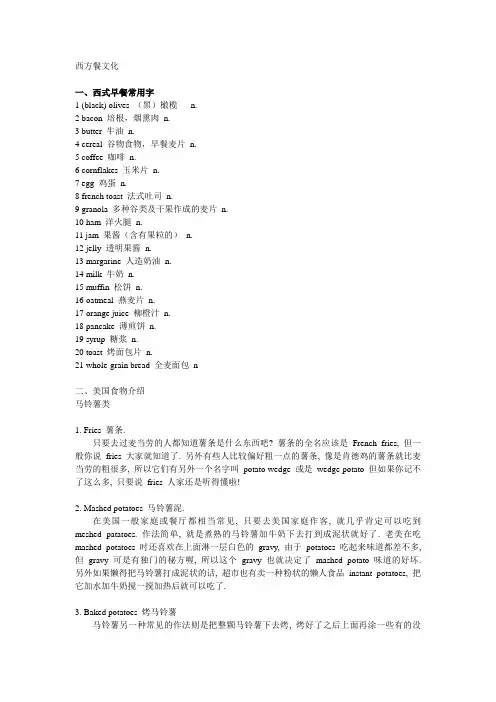
西方餐文化一、西式早餐常用字1 (black) olives (黑)橄榄n.2 bacon 培根,烟熏肉n.3 butter 牛油n.4 cereal 谷物食物,早餐麦片n.5 coffee 咖啡n.6 cornflakes 玉米片n.7 egg 鸡蛋n.8 french toast 法式吐司n.9 granola 多种谷类及干果作成的麦片n.10 ham 洋火腿n.11 jam 果酱(含有果粒的)n.12 jelly 透明果酱n.13 margarine 人造奶油n.14 milk 牛奶n.15 muffin 松饼n.16 oatmeal 燕麦片n.17 orange juice 柳橙汁n.18 pancake 薄煎饼n.19 syrup 糖浆n.20 toast 烤面包片n.21 whole-grain bread 全麦面包n二、美国食物介绍马铃薯类1. Fries 薯条.只要去过麦当劳的人都知道薯条是什么东西吧? 薯条的全名应该是French fries, 但一般你说fries 大家就知道了. 另外有些人比较偏好粗一点的薯条, 像是肯德鸡的薯条就比麦当劳的粗很多, 所以它们有另外一个名字叫potato wedge 或是wedge potato 但如果你记不了这么多, 只要说fries 人家还是听得懂啦!2. Mashed potatoes 马铃薯泥.在美国一般家庭或餐厅都相当常见, 只要去美国家庭作客, 就几乎肯定可以吃到meshed patatoes. 作法简单, 就是煮熟的马铃薯加牛奶下去打到成泥状就好了. 老美在吃mashed potatoes 时还喜欢在上面淋一层白色的gravy, 由于potatoes 吃起来味道都差不多, 但gravy 可是有独门的秘方喔, 所以这个gravy 也就决定了mashed potato 味道的好坏. 另外如果懒得把马铃薯打成泥状的话, 超市也有卖一种粉状的懒人食品instant potatoes, 把它加水加牛奶搅一搅加热后就可以吃了.3. Baked potatoes 烤马铃薯马铃薯另一种常见的作法则是把整颗马铃薯下去烤, 烤好了之后上面再涂一些有的没的例如像是sour cream (酸奶) chives (一种葱类), cheese (起司), 或是olives (橄榄). 通常你去好一点的餐厅点bake potatoes 它们都会问你上面要加什么, 如果你像我一样不喜欢那些有的没的, 就跟他说, "I want it plain." 就好啦!注1: 有些人来到美国一看sweet potatoes 就很高兴地以为这是一种新品种的超甜马铃薯, 其实不要被骗了, sweet potatoes 己经陪我们的老祖宗走过好几千年啦! 他的中文名称就叫甘薯.注2: Potatoes 在台湾方面翻译成马铃薯, 但在大陆方面却称potatoes 为土豆, (在台湾称花生才叫土豆!!) 实在蛮有意思的.蔬菜类、饮食类1. Baked bean 甜豆.这种吃起来甜甜的豆子老美非常地喜爱, 所以才会到处可见. 做法很简单是把一种甜甜的豆子煮的烂烂, 看起来有点像调味料一样. 有一次去餐厅吃饭, 我跟我同学点了baked bean 当side dish, 结果我同学大概因为没看过baked bean, 以为这是牛排酱还是什么佐料, 结果居然拿牛排去沾baked bean. 害我们大家都笑得要死说.2. Green bean 四季豆四季豆不论在中外都很常见, 唯一不同的是美式的煮法是用水煮到烂, 不像是中式料理喜欢用大火快炒, 因为老美喜欢蔬菜吃起来烂烂的, 不像我们老中喜欢吃脆脆的口感. 所以像我这么喜欢吃四季豆的人来美国之后都没吃过几次Green bean, 因为烂烂的四季豆实在是不怎么样.3. Cole slaw 高丽菜沙拉.Cole slaw 是一个法文, cole 是法文里高丽菜的意思, 而slaw 则是沙拉的意思. 所以cole slaw 就是一种高丽菜沙拉, 它把高丽菜和红萝卜切成细细的, 扮上一种特别白色的酱汁. 有时老美也不单吃cole slaw, 他们会把面包夹热狗再夹cole slaw, 就变成了好吃的热狗三明治.4. Creme corn 奶油玉米老美的作法是把煮熟的甜玉米跟奶油状的液体(creme) 搅拌均匀就大功告成了, 这道菜是老美招待客人时偷懒最好的伴侣. 懒人餐中可以跟creme corn 相提并论的是水煮豌豆(pea), 只要买一罐豌豆罐头回来加热一下就可以上桌了!5 Scrambled eggs 炒蛋这个没什么学问, 跟中式炒蛋一样, 把蛋打一打炒一炒就好了, 但是份量惊人, 我第一次吃Scrambled eggs, 就是四个蛋作成的, 怪不得老美胖子特多. 另外老美的Scrambled eggs 跟中式炒蛋不同之处在于, 通常他们不放盐或是葱花等调味料, 而是放一片Cheese 去调味,所以吃起来味道不太一样. 不过有些人不喜欢炒蛋, 而比较喜欢荷包蛋. 到餐厅点荷包蛋的讲法是sunny side up, 因为荷包蛋看起来是不是很样一个小学生画的太阳?6. Omelette (Omelet) 煎蛋卷如果早餐喜欢吃台湾蛋饼的人, 不妨试试老美的蛋饼Omelette, 它的作法是把一层煎蛋卷起来, 里面包火腿, 培根或是洋葱, 青椒, 洋菇甚至是牛排等料, 还算不错, 在像是Waffle House 或IHOP 这样的速食连锁店都可以吃到这种道地的美国食物.7.Hash browns 薯饼这个hash browns 是麦当劳的超值早餐常见的一道菜色, 作法是把马铃薯削成丝状, 再下去油炸, 通常是碎碎的, 但是像麦当劳的Hash brown 却是饼状的, 所以这应该叫作Hash brown patty (薯饼) 才对. 另外麦当劳早餐的另一样主打菜是biscuits, 中文翻成比士吉, 这是一种小圆面包, 老美的吃法习惯在中间包蛋, 起司或是香肠(sausage) 像这两样早餐我想在台湾的麦当劳也同样常见.8. Brownie 布朗尼Brownie 算是蛋糕的一种, 但它和一般蛋糕的区别在于, Brownie 通常较薄且较结实, 不像蛋糕松松的, 而且一定是巧克力口味, 上面还会放杏仁或花生作装饰及调味. 通常很甜. 拿来当早餐吃相当不错.9.Pancake 烤薄饼它的原料是面粉和蛋, 下去用油煎成约手掌大小的薄饼, 通常吃的时候会再淋上糖浆(Syrup)-- Syrup 最早是从一种特殊的枫树而来, 在美国你还可以买下一整棵枫树, 然后主人每年会把这棵树收成的Syrup 寄给你. 但是天然的Syrup 很贵, 现在一般吃的多半为人工合成. 美国卖Pancake 的连锁店叫IHOP: International House of Pancake, 去这里吃东西, 不管你点什么, 他们都会送你一份Pancake.10. Waffle 蜂蜜松饼(福华饼)这个东西在台湾就很多, 像是那个玫瑰园就有在卖, 它的味道跟Pancake 味道差不多, 但Waffle 比较大, 而且上面是一格一格的, 吃的时候也是要配奶油或是Syrup. 再切成一小块一小块吃. 在美国也有在卖冷冻的Waffle, 早上起来把它放到烤箱里烤个7-8 分钟就可以吃了, 是简单又实惠的早餐之一.11.Cheesecake 起司蛋糕这种蛋糕很甜, 但它偏偏又很大, 所以二个人点一份就差不多了. 有些人很爱吃, 但个人并不怎么喜爱, 因为它太甜了. 美国有一家很有名的餐厅就叫Cheesecake 很有名, 每天都大排长龙, 它的Cheesecake 当然是最有名, 但是它也兼卖一般的食物, 如Babyback rib 就很不错, 有机会可尝尝.12. Donut (Doughnut) 甜甜圈喜欢吃甜甜圈的人一定要到美国来, 美国的甜甜圈种类既多且繁, 而且美国有一家很有名的Fast Food 就叫Dunkin' Donuts, 算是Donut 的权威吧. 美国人真的很喜欢Donut, 他们买都不是以个为单位, 要买都是半打一打的买. 我看美国很多胖子都是吃Donut 吃出来的.13. Bagel 圈饼形状跟甜甜圈很像, 都是中间有一个洞洞, 但是质地很硬, 有点类似台湾的光饼, 但口味有许多种, 如小蓝苺, 巧克力, 起司等, 老美吃Bagel 时会在上面涂一层cream cheese. 有些餐厅还再放上一些好料如培根, 牛肉, 鸡肉或是鲑鱼加上一点生菜, 西红柿, 跟汉堡的作法很类似.14. Muffin 松饼这个字的读音像" 马粪" 虽然不雅, 但是可以帮助记忆, Muffin 是甜的小蛋糕, 像海绵蛋糕但较硬, 大多是杯状的有时是像圆面包状, 有许多不同口味! 通常是小蓝梅, 蜂蜜, 肉桂或巧克力口味三、麦当劳食物介绍1. 套餐(combo)通常看著图片就知道几号是什么套餐, 点套餐时只要说Combo number one, 或是number one 就好了. 有时店员会问, Do you want to go large? 如果你需要, 他会给你大的薯条和可乐.2. 汉堡(hamburger)老美说汉堡通常会说burger 如cheese burger. 和台湾不同的是, 在美国单点汉堡他会问你goes with cheese? 所以也可以在点的时候就说without cheese, 他就不会再问你. 有些比较好的餐厅还会问你肉要几分熟. 有意思吧.3. 薯条(fries)记得以前国中英语教french fries, 在美国说fries 就可以了.4. 饮料(drinks)在速食店的饮料就那么几种 a. 可乐coke b. 减肥可乐diet coke (或直接说diet) c. 雪碧sprite (柠檬汽水) d. 橘子汽水Hi-C (or orange soda) e. 冰茶(iced tea) 在美国的soft drink大多数是可以refill 的, 你可以在店里喝一杯, 离去时再去refill 一杯, 相当划算.附记:1. 有些老美喜欢用"Micky D's" 代替"McDonalds." 例如"Yang, wanna grab some Micky D's?", "Let's go to Micky D's2. 在美国的麦当劳和台湾不同的是, 它们的西红柿酱都是自己用的, 它会有另外一个小台子摆酱及吸管. 但是如果你是外带, 他就会你要什么酱(which sauce do you like) 你就可以答说ketchup 或是BBQ sauce3. 有些店的奶精跟糖是摆在外面给你自己拿的, 这时你如果点咖啡他们就不会问你Cream or sugar? 但有些店会把奶精跟糖收在柜台后面, 这时他们就会问你, Cream or sugar?4. 如果你点的是套餐, 你可以跟他说Can I biggie size it? 那么他就会给你大份的薯条和大杯的可乐, 通常只要再加30 cents 左右就可以了.5. 最有效率的点餐说法, Three, ketup, Coke to go. 意思是Combo number three, give me ketup, I want Coke and to go! 真是一点废话都没有.四、西方礼仪:餐巾的使用方法1、点完餐后再打开餐巾是为了在用餐时防止衣服弄脏而准备的。
餐饮产品由于地域特征、气侯环境、风俗习惯等因素的影响,会出现在原料、口味、烹调方法、饮食习惯上的不同程度的差异。
正是因为这些差异,餐饮产品具有了强烈的地域性。
中西文化之间的差异造就了中西饮食文化的差异,而这种差异来自中西方不同的思维方式和处世哲学。
中国人注重“天人合一”,西方人注重“以人为本”。
这里简要从下面三个方面谈谈中西方饮食文化的差异。
The dining product as a result of factor and so on region characteristic, climatic environment, manners and customs influences, will appear in raw material, the taste, the cooking method, the food habit varying degree difference. Was precisely because of these differences, the dining product had the intense localization. Between China and the West culture's difference has accomplished China and the West diet culture difference, but this kind of difference and gets along with people the philosophy from the West different thinking mode. The Chinese pays great attention “the beauty to uni te”, the westerner pays great attention “humanist”. here chats the Western diet culture difference briefly from the following three aspects. 第二种翻译:Food products due to geographical features, climate, customs, and other factors, will appear in the raw materials, food, cooking methods, dietary habits on the varying degrees of difference. It is precisely because of these differences in food products with a strong regional. The difference between Chinese and Western cultures to create a diet of Chinese and Western cultural differences, and differences from the West in a different way of thinking and philosophy of life. Chinese people pay attention to the "Heaven and Man," in the West focus on "people-oriented."From here, a brief talk about the following three areas in the Western diet and cultural differences.一、两种不同的饮食观念对比注重“味”的中国饮食,西方是一种理性饮食观念。
Differences between Chinese and Western diet culture Can you imagine the difference between the Western diet culture and the Chinese diet culture?First of all, I will introduce the general characteristics of Western diet culture. Western diet historyItaly cuisine is the originator of the Western diet culture, French cuisine is the Western diet culture king, American food is the Western diet culture upstart.Western food making skillsIn the production of the Western diet, they love the pursuit of perfection, but also attach importance to cooperation with a delicacy.Western diet varietiesThe famous dishes are Italy, French, American, German, Russian, etc. famous drinks include wine, coffee and black tea.Do you know,why there are so many differences between Chinese and Western diet culture ?just like the menu,western diet is very tidy and serious,but the Chinese is multifarious.Now, you have known the difference of the menu,but do you know why diet has a strong regional character?Actually, western diet due to geographical characteristics, environment, customs, appears in cooking methods ofdifferences in eating habits. People in western countries like to eat pizza, while Chinese people like to eat dumplings.Differences between Chinese and Western culture makes a difference of Chinese and Western food culture.事实上,西方饮食由于地域特色、环境、风俗习惯,出现烹调方法不同程度的差异。
外国餐饮文化英语介绍作文Title: Exploring Foreign Culinary Culture。
Introduction:In the vast realm of culinary delights, exploring foreign cuisines is akin to embarking on a gastronomic adventure. Each culture boasts its unique flavors, cooking techniques, and dining traditions, offering a tapestry of experiences to tantalize the taste buds and broaden one's culinary horizons. Let us delve into the rich tapestry of foreign culinary cultures through the lens of English discourse.Italian Cuisine:Italian cuisine, renowned worldwide for its simplicity and robust flavors, embodies the essence of Mediterranean cooking. From the aromatic allure of basil and oregano to the rich, velvety texture of freshly made pasta, every dishtells a story of tradition and passion. Pasta dishes like spaghetti carbonara and risotto showcase the artistry of Italian chefs, while wood-fired pizzas with their crispy crusts and melty cheese evoke a sense of culinary bliss. The Italian dining experience extends beyond food; it's about gathering with loved ones, sharing hearty meals, and savoring each moment with gusto.Japanese Cuisine:Japanese cuisine is a harmonious blend of precision, balance, and reverence for nature. With its emphasis on fresh, seasonal ingredients and meticulous preparation, Japanese dishes are a feast for the senses. Sushi, perhaps the most iconic of Japanese fare, epitomizes this ethos with its delicate flavors and artful presentation. From nigiri to sashimi, each bite reflects centuries of culinary refinement. Additionally, dishes like tempura and yakitori showcase Japan's mastery of frying and grilling techniques. Beyond the culinary realm, the Japanese dining experience embodies etiquette and mindfulness, with rituals like the tea ceremony symbolizing respect and gratitude.Indian Cuisine:Indian cuisine is a symphony of spices, colors, and textures that reflect the country's diverse cultural heritage. With its myriad regional variations, Indian food offers a treasure trove of flavors to explore. From the fiery heat of dishes like vindaloo to the creamy indulgence of butter chicken, each dish tells a story of history and heritage. Vegetarian fare also holds a prominent place in Indian cuisine, with dishes like paneer tikka and dal showcasing the versatility of plant-based ingredients. Dining in India is a communal affair, with meals often served family-style and accompanied by lively conversation and laughter.French Cuisine:French cuisine, often hailed as the epitome of culinary sophistication, is synonymous with elegance and indulgence. From the delicate pastries of Parisian patisseries to the hearty stews of the countryside, French food celebrates theart of indulgence. Classic dishes like coq au vin and boeuf bourguignon exemplify the French penchant for slow-cooked comfort food, while haute cuisine offerings elevate dining to a culinary spectacle. The French dining experience is imbued with a sense of joie de vivre, where meals are savored slowly, wine flows freely, and each bite is a celebration of life's simple pleasures.Conclusion:In conclusion, exploring foreign culinary cultures is not just about satisfying hunger; it's about connecting with the world around us, celebrating diversity, and embracing new experiences. Whether indulging in the comforting embrace of Italian pasta or savoring thedelicate flavors of Japanese sushi, each culinary tradition offers a window into the soul of a culture. So let us raise our forks and embark on a journey of taste and discovery, one delicious bite at a time. Cheers to the endless wonders of the culinary world!。
西方餐桌文化英文作文英文:Table culture in the Western world is quite different from that in the East. In the West, dining is seen as a social activity and a way to connect with others. Meals are often shared, and conversation is encouraged. Table manners are also important, as they show respect for the host and other guests.One major difference between Western and Eastern table culture is the use of utensils. In the West, forks, knives, and spoons are used to eat most foods, while in the East, chopsticks are the primary utensil. In addition, in the West, it is common to use a napkin to wipe one's mouth during the meal, while in the East, a small towel is often provided for this purpose.Another aspect of Western table culture is the use of courses. Meals are often served in multiple courses, witheach course consisting of a different type of food. This allows for a variety of flavors and textures, and also helps to pace the meal. In the East, meals are typically served all at once, with a variety of dishes placed on the table at the same time.In terms of conversation, the West places a strong emphasis on engaging with others during the meal. It is common to ask about someone's day, share stories, and discuss current events. In the East, conversation is often more subdued, and there may be more focus on enjoying the food and the company.Overall, Western table culture is centered around socializing and enjoying the meal together. Utensils, courses, and conversation all play a role in creating a pleasant dining experience.中文:西方餐桌文化与东方有很大的不同。
西方餐饮文化英文作文下载温馨提示:该文档是我店铺精心编制而成,希望大家下载以后,能够帮助大家解决实际的问题。
文档下载后可定制随意修改,请根据实际需要进行相应的调整和使用,谢谢!并且,本店铺为大家提供各种各样类型的实用资料,如教育随笔、日记赏析、句子摘抄、古诗大全、经典美文、话题作文、工作总结、词语解析、文案摘录、其他资料等等,如想了解不同资料格式和写法,敬请关注!Download tips: This document is carefully compiled by theeditor. I hope that after you download them,they can help yousolve practical problems. The document can be customized andmodified after downloading,please adjust and use it according toactual needs, thank you!In addition, our shop provides you with various types ofpractical materials,such as educational essays, diaryappreciation,sentence excerpts,ancient poems,classic articles,topic composition,work summary,word parsing,copyexcerpts,other materials and so on,want to know different data formats andwriting methods,please pay attention!In Western restaurants, the atmosphere is usually quite relaxed. People chat and laugh freely.The food presentation is often very artistic, with carefully arranged dishes.Service is also an important part. Waiters and waitresses are polite and attentive.And the variety of cuisines is amazing, from Italian pasta to French pastries.There are different etiquette rules to follow, like using the right cutlery.The wine culture is also very prominent, with different wines paired with different dishes.。
西方饮食文化英语礼仪饮食文化可以从时代与技法、地域与经济、民族与宗教、食品与食具、消费与层次、民俗与功能等多种角度进行分类,展示出不同的文化品味,体现出不同的使用价值,异彩纷呈。
接下来是小编为您整理的西方饮食文化英语礼仪,希望对您有所帮助。
西方饮食文化英语礼仪1The culture differences between the East and West.As we know ,there are so many differences between culture of the East and West that I can not list all of their different aspects.I will focus on the differences of diet custom and teaching system.For your better understanding ,I will set examples of China and America.It is no doubt that it is a tradition to use chopsticks for Chinese.But people in America prefer to forks and knives.This different result is based on different food they are like .Americans choose to eat beefsteak,bread,and salad,while Chinese people choose noodles ,pancakes and rice.What is more,the custom of drinking tea in China and drinking coffee in America are stand out particularly.However,there is a trend that the food in both countries has been mixture.For example,the coffee and bread have introduced to China.The famous KFC is very popular at children.The gap of teaching system between China and America is big.Chinese students always complain about their homework.Too much homework has limited the time to exercise and relax.They have to recite many things as to get a high mark.Homework comes the first to them.In my opinion,the study in America is more interesting .Teachers pay attentions to training students skills inthinking in realastic life not to emphasis on the importances of memories.In a addition,the rate of going to school ,the salary of teaching ,and the job of gruduates are quite different,too.I should say that Chima government should make great efforts to improve its teaching syetem.I am also expect to be one day ,the West give more cheers to our country.西方饮食文化英语礼仪2Of course, the main difference on the Chinese dinner table is chopsticks instead of knife and fork, but that’s only superficial. Besides, in decent restaurants, you can always ask for a pair of knife and fork, if you find the chopsticks not helpful enough. The real difference is that in the West, you have your own plate of food, while in China the dishes are placed on the table and everyone shares. If you are being treated to a formal dinner and particularly if t he host thinks you’re in the country for the first time, he will do the best to give you a taste of many different types of dishes.The meal usually begins with a set of at least four cold dishes, to be followed by the main courses of hot meat and vegetable dishes. Soup then will be served (unless in Guangdong style restaurants) to be followed by staple food ranging from rice, noodles to dumplings. If you wish to have your rice to go with other dishes, you should say so in good time, for most of the Chinese choose to have the staple food at last or have none of them at all.Perhaps one of the things that surprises a Western visitor most is that some of the Chinese hosts like to put food into the plates of their guests. In formal dinners, there are always "public" chopsticks and spoons for this purpose, but some hosts may use their own chopsticks. This is a sign of genuine friendship andpoliteness. It is always polite to eat the food. If you do not eat it, just leave the food in the plate.People in China tend to over-order food, for they will find it embarrassing if all the food is consumed. When you have had enough, just say so. Or you will always overeat![西方饮食文化英语礼仪]。